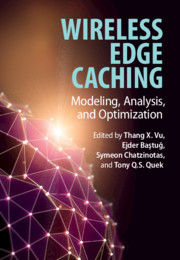Book contents
- Frontmatter
- Contents
- List of Contributors
- Preface
- 1 Introduction
- Part I Optimal Cache Placement and Delivery
- Part II Proactive Caching
- Part III Cache-Aided Interference and Physical Layer Management
- 11 Cache-Enabled Cloud Radio Access Networks
- 12 Fundamentals of Coded Caching for Interference Management
- 13 Full-Duplex Radios for Edge Caching
- 14 Caching in Mobile Millimeter Wave: Sub-6 GHz Networks
- Part IV Energy-Efficiency, Security, Economic, and Deployment
- Index
13 - Full-Duplex Radios for Edge Caching
from Part III - Cache-Aided Interference and Physical Layer Management
Published online by Cambridge University Press: 19 October 2020
- Frontmatter
- Contents
- List of Contributors
- Preface
- 1 Introduction
- Part I Optimal Cache Placement and Delivery
- Part II Proactive Caching
- Part III Cache-Aided Interference and Physical Layer Management
- 11 Cache-Enabled Cloud Radio Access Networks
- 12 Fundamentals of Coded Caching for Interference Management
- 13 Full-Duplex Radios for Edge Caching
- 14 Caching in Mobile Millimeter Wave: Sub-6 GHz Networks
- Part IV Energy-Efficiency, Security, Economic, and Deployment
- Index
Summary
This chapter focuses on the performance enhancement brought by the addition of caching capabilities to full-duplex (FD) radios in the context of ultra-dense networks (UDNs). In particular we aim at showing that the interference footprint of such networks, i.e., the major bottleneck to overcome to observe the theoretical FD throughput doubling at the network level, can be significantly reduced thanks to edge caching. A caching model is designed to mimic a geographical caching policy based on the popularity of local files and to compute their associated cache-hit probability. Subsequently, we calculate the probability of successful transmission of a file requested by a use equipment, either directly by its serving small cell base station (SCBS) or by the corresponding backhaul node (BN): this quantity is then used to lower-bound the throughput of the considered network. Our approach makes use of tools from stochastic geometryto guarantee the generality of our results and analytical tractability of the problem.
- Type
- Chapter
- Information
- Wireless Edge CachingModeling, Analysis, and Optimization, pp. 257 - 278Publisher: Cambridge University PressPrint publication year: 2021

